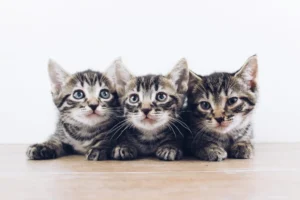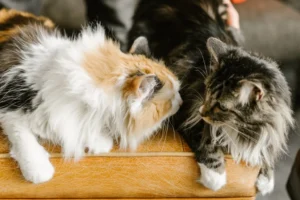Cats are known for their unique ways of showing affection, including biting. Have you ever wondered why cats use biting as a way to express love? Let’s explore the fascinating reasons behind this common feline behavior.
Cats bite to show affection as a form of communication, bonding, and even playfulness. When a cat gently nibbles on your hand or arm, it is often a sign of endearment and trust. Understanding the motivations behind this behavior can help strengthen the bond between you and your feline friend.
Communication through Biting
Cats have their unique way of expressing their emotions, and biting is one of them. When your feline friend gives you a gentle nibble, it might not be an act of aggression but rather a form of communication. Cats use biting as a way to convey their feelings, whether it’s affection, excitement, or even irritation. It’s essential to pay attention to the context in which the biting occurs to understand what your cat is trying to communicate.
For example, if your cat gently nips at your hand while you’re petting them, it could be a sign that they are enjoying the interaction and want to continue. On the other hand, if your cat bites a little harder or hisses while doing so, they might be feeling overstimulated and in need of a break. Understanding these subtle cues can help strengthen the bond between you and your feline companion.
Bonding Behavior
Biting can also be a way for cats to strengthen their bond with their favorite humans and other pets. When a cat engages in gentle nibbling or licking as a form of affection, it’s a sign that they trust and feel comfortable in your presence. By reciprocating this behavior with gentle petting and positive reinforcement, you can further deepen the bond with your furry friend.
Moreover, biting during playtime is a common bonding behavior among cats. When your cat playfully bites during a game, it’s their way of showing affection and enjoying the interaction with you. Encouraging this playful behavior through interactive toys and positive reinforcement can help foster a strong bond between you and your cat.
In addition to bonding with humans, cats may also engage in social grooming with other pets to strengthen their relationships. This behavior involves gentle biting and grooming as a way to maintain social bonds within their group. By observing and understanding these bonding behaviors, you can help create a harmonious environment for all your furry companions.
Remember, positive reinforcement and clear communication are key when it comes to understanding why cats bite to show affection. By paying attention to your cat’s cues and responding with love and patience, you can cultivate a strong and loving bond that will last a lifetime.
Playful Biting vs. Aggressive Biting
Cats use biting as a way to show affection, but it’s important to distinguish between playful and aggressive behavior. Playful biting is usually gentle, with minimal pressure applied, often accompanied by purring or kneading. On the other hand, aggressive biting is forceful, may be accompanied by hissing or growling, and can result in injury.
When your cat playfully bites during affectionate interactions, it’s typically a sign of excitement or overstimulation. In such cases, respond by redirecting their attention to a toy or ending the interaction calmly to give your cat a chance to calm down. However, if your cat’s biting becomes aggressive, it’s essential to establish boundaries to prevent harm.
Setting Boundaries
To prevent unwanted or excessive biting during affectionate interactions, establish clear boundaries with your cat. One effective way to do this is through positive reinforcement training. When your cat engages in gentle behavior, reward them with treats or praise to reinforce that behavior.
Additionally, provide appropriate outlets for your cat’s natural instincts, such as scratching posts and interactive toys, to redirect their biting behavior. Consistency is key when setting boundaries, so be patient and reinforce positive behavior regularly.
Setting boundaries with your cat not only helps prevent unwanted biting but also strengthens the bond between you and your feline companion. By showing them love and respect while also establishing limits, you can create a harmonious relationship based on trust and understanding.
Additional Unique Insight:
Consider using bitter apple spray on items you don’t want your cat to bite, as the taste is unpleasant to cats and can discourage them from chewing on those objects.
Remember, understanding why cats bite to show affection and how to respond appropriately can improve the quality of your interactions with your feline friend. By setting boundaries and addressing biting behavior effectively, you can foster a loving and respectful relationship with your cat.
Redirecting Behavior
If your cuddly feline friend has a habit of showing affection through gentle nips, it’s essential to redirect this behavior positively. Provide plenty of engaging toys and scratching posts to give your cat an appropriate outlet for their playful bites. When your cat starts to nip, simply replace your hand or skin with a toy. This way, your cat can still express their affection without causing any harm. Consistency is key in training your cat to redirect their biting behavior, so be patient and persistent in encouraging this positive change.
Understanding Body Language
When your cat playfully nips at you, it’s crucial to decipher whether it’s a sign of affection or discomfort. Pay close attention to their body language to determine their intentions. A relaxed and content cat may lightly bite during affectionate moments, accompanied by purring and kneading. On the other hand, an agitated or fearful cat might resort to biting as a defensive mechanism. By understanding your cat’s body language cues, you can respond appropriately to their behavior and strengthen your bond with your furry companion.
Body Language Cues to Look For:
- Relaxed posture with a gently swishing tail
- Purring, kneading, and relaxed facial expressions
- Ears forward or slightly to the side
- Playful behavior, such as engaging in gentle nibbles during interactive play
By recognizing these body language signals, you can better interpret your cat’s intentions and respond accordingly to foster a loving and harmonious relationship with your feline friend.
Consistency in Training
When it comes to addressing unwanted biting behavior in your feline friend, consistency in training is key. Cats are intelligent creatures that respond well to routine and predictability. By consistently reinforcing positive behaviors and redirecting negative ones, you can effectively minimize biting incidents. Remember, cats thrive on structure, so make sure to establish clear boundaries and stick to them.
One effective way to ensure consistency is to establish a routine for playtime, meals, and affection. By providing your cat with a stable environment, you can help reduce stress and anxiety, which can sometimes lead to aggressive behaviors like biting. Additionally, be sure to communicate with your cat using consistent cues and body language to reinforce your expectations.
Remember, consistency is not about punishment but about setting clear expectations and boundaries. By being patient and consistent in your training efforts, you can create a harmonious and loving relationship with your furry companion.
Positive Reinforcement
Ever wondered why cats bite to show affection? One possible reason is that biting is a natural behavior for cats to show their love and affection, similar to grooming each other. Understanding this behavior can help you encourage positive interactions with your cat.
One effective way to promote desirable behaviors in your cat and discourage unwanted biting is through positive reinforcement. This involves rewarding your cat with treats, praise, or playtime when they exhibit gentle displays of affection, such as rubbing against you or sitting calmly in your lap. By consistently using positive reinforcement techniques, you can encourage your cat to engage in more desirable behaviors while strengthening your bond.
Remember, patience is key when using positive reinforcement. It may take time for your cat to learn which behaviors are rewarded, so be consistent and patient in your training efforts. By focusing on positive interactions and reinforcing good behavior, you can cultivate a strong and loving relationship with your feline companion.
Alex, a passionate animal lover, has experience in training and understanding animal behavior. As a proud pet parent to two dogs and three cats, he founded AnimalReport.net to share insights from animal experts and expand his knowledge of the animal kingdom.









